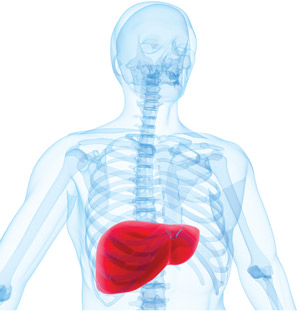Jul. 8, 2011 Research Highlight Biology
Pinpointing a tell-tale mark of liver cancer
A newly identified gene variant could lead to predictive tests for a major cause of cancer-related deaths
 Figure 1: Individuals who carry a specific genetic variant and become infected with the hepatitis C virus could be susceptible to developing liver cancer. © 2011 iStockphoto/ Eraxion
Figure 1: Individuals who carry a specific genetic variant and become infected with the hepatitis C virus could be susceptible to developing liver cancer. © 2011 iStockphoto/ Eraxion
Persistent hepatitis C virus (HCV) infection can lead to chronic hepatitis C and then progress to fatal liver diseases including liver cirrhosis and liver cancer, the third most common cause of cancer-related deaths. Worldwide, more than 170 million people are infected with HCV, and the virus accounts for 30–70% of liver cancer cases. The recent identification of a genetic variant associated with increased susceptibility to hepatitis C virus-induced liver cancer could have major implications for global healthcare, as it may lead to tests that predict liver cancer susceptibility.
Michiaki Kubo of the RIKEN Center for Genomic Medicine and colleagues from RIKEN and The University of Tokyo discovered the variant by analyzing the entire genomes of 721 Japanese individuals with HCV-induced liver cancer and comparing them with those of 2,890 HCV-negative controls1. This allowed them to identify variants potentially associated HCV-induced liver cancer (Fig. 1). They confirmed the association of one variant by replicating the study in another 673 liver cancer patients and 2,596 controls.
This variant was located within a region on chromosome 6, which contains many genes that are critical for immune system function. It lies between the genes encoding MICA, a membrane protein that activates the anti-tumor effects of white blood cells, and the HLA-B gene, which encodes a peptide that enables the immune system to distinguish between the body’s own proteins and those produced by invading microbes.
The researchers checked the variant in another 1,730 individuals with chronic hepatitis C who had not developed liver cirrhosis or liver cancer, and revealed that it was significantly associated with progression from chronic hepatitis C to liver cancer, but not with susceptibility to chronic hepatitis C.
Finally, Kubo and colleagues examined MICA protein levels in patients with chronic hepatitis C and HCV-induced liver cirrhosis, and found that the level of MICA in blood samples was elevated during early stages of the disease compared to healthy controls. They also found that the identified variant was correlated with low MICA levels in patients with chronic hepatitis C.
These findings suggest that individuals carrying the genetic variant would express low levels of MICA. This in turn would lead to reduced response by white blood cells to cells infected with viruses, increasing the likelihood of progression from chronic hepatitis C to liver cancer.
“Our results suggest that low serum MICA levels are a marker for higher susceptibility to progression of liver cancer in the patients with chronic hepatitis C,” says Kubo.
References
- 1. Kumar, V., Kato, N., Urabe, Y., Takahashi, A., Muroyama, R., Hosono, N., Otsuka, M., Tateishi, R., Omata, M., Nakagawa, H. et al. Genome-wide association study identifies a susceptibility locus for HCV-induced hepatocellular carcinoma. Nature Genetics 43, 455–458 (2011). doi: 10.1038/ng.809
